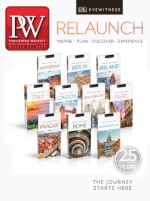A common theme runs through several of the newest guidebooks: they turn the focus back on the traveler, detailing not just where to go but why one might want to go there.
At Avalon Travel, says Kevin McLain, v-p, editorial, new guides home in on specific, and sometimes idiosyncratic, interests. The recently released Moon Nevada by Scott Smith, for one, casts the state, which most often conjures images of Las Vegas glitz, as a recreation and road trip destination. Similarly, Moon Los Angeles by Halli Jastaran Faulkner (Oct.) focuses less on the dominant Hollywood film culture—though that’s covered, too—and more on exploring the city’s diverse neighborhoods. Targeted itineraries aim to showcase the best aspects of the city for families, beach lovers, art enthusiasts, and, of course, film buffs.
McLain also points to Moon Nashville to New Orleans Road Trip by Margaret Littman (out now) as a guide that could lead visitors away from stereotypical notions. “These are places that blue state residents might have preconceived ideas about, yet they’re very hospitable to visitors,” he says. “The focus is on the great local music and food. What better way to establish human connections that transcend politics?”
Perceptions of travel are constantly shifting, allowing guidebooks to wade into once unfamiliar territory—like when Lonely Planet cofounder Tony Wheeler announced to Piers Pickard, the company’s managing director, publishing, that he’d just returned from a cruise and loved it. The fact that Wheeler, a renowned backpacking guru, embarked on such a pursuit—something he wouldn’t have been eager to do in the past—led Pickard to realize “that cruising didn’t mean what it meant 10 years ago,” he says. “You don’t have to only do the highlights of the Mediterranean anymore.”
To reflect this new perspective, Lonely Planet released Cruise Ports guides to Alaska, the Caribbean, and Scandinavia and Northern Europe in June. Next up is January’s The Cruise Handbook, which focuses less on specific ports of call and more on the interests and needs of a variety of different travelers by listing, for instance, the top five LGBTQ cruises, top 10 affordable cruises, and journeys that suit solo or vegan and vegetarian travelers. The book also offers more general cruise-prep advice on practicalities such as packing, etiquette, and maximizing excursions at ports of call.
DK is giving its Eyewitness Travel Guides a significant revamp this fall, which marks the line’s 25th anniversary. Now printed on uncoated paper and sporting a more modern binding, the lightweight guides make room for infographics, more-detailed maps, and new content including themed spreads and “reasons to love” shout-outs for each destination. The redesigned series kicks off in October with 10 destinations, among them Amsterdam, Ireland, and Washington, D.C.
The makeover was a major investment but a worthwhile one, publishing director Georgina Dee says, that resulted from extensive research into “what people wanted and didn’t want” in a guidebook. Eyewitness’s hand-drawn illustrations and expert tips remain, balanced by updated photography—less of it, but running at a larger size. It’s a look that’s meant to resonate beyond the coveted millennial demographic. “There’s a move in the baby boomer segment toward experiential and authentic,” Dee says. “They want to get under the skin of a destination, too.”



 Volume 265
Issue 33
08/13/2018
Volume 265
Issue 33
08/13/2018





